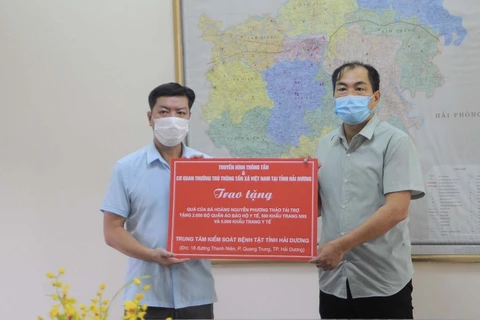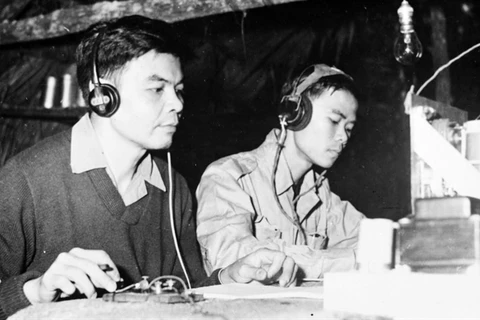
On September 15, 1945, the full text of the Declaration of Independence giving birth to the Democratic Republic of Vietnam was aired in Vietnamese, English and French by the Vietnam News Agency, marking the establishment of the State news agency. (Photo: VNA)
Hanoi (VNA) - Throughout its 75-year history, the Vietnam News Agency (VNA) has always been accompanying the nation and joining hands with the whole Party, people, and army, along the nine-year resistance war against the French that culminated in the resounding Dien Bien Phu victory, as well as the 21-year battle against the US that ultimately led to the Great Spring Victory in 1975 and the reunification of the country and the taking of the path towards socialism.
Both witness of and contributor to history
During Vietnam’s struggles for national independence, journalists from VNA, known as “Viet Nam Thong tan xa” (VNTTX) at the time, became journalist-soldiers who not only reported events as witnesses but also directly engaged in such events.
Throughout the nine years of the anti-French resistance war, the fledgling VNA staff, small as it was, both fought the enemy and ensured information and communications tasks were also completed. It overcame numerous difficulties, moving its base 21 times to avoid the enemy, during which reporters fought for their survival and moved equipment at the same time, maintaining the flow of information to serve the Party and President Ho Chi Minh. Many VNA members laid down their lives, including Tran Kim Xuyen, Vice Director of the Ministry of Home Affairs’ Vietnam Information Department and the first leader of VNA, who died in 1947, becoming the first VNA journalist-martyr.

President Ho Chi Minh, Vice President Ton Duc Thang and comrade Truong Chinh pose for a photo with reporters of the Vietnam News Agency in 1960 (Photo: VNA)
After 1954, VNA entered into a new period of development. Along with the reporting of news on land reform, industry and trade renovation, and the building of socialism in the north, it also took charge of covering the struggle in the south against the US forces and the US-backed administration. As the US escalated its attacks on the north, VNA arranged its forces and stood ready to fight in protection of its bases, while strengthening its equipment to make it more professional while expanding its coverage of news for domestic and foreign readers.
In early 1960, the revolution in the south entered a phase of massive uprising. Along with completing its duty in terms of news coverage, VNA also prepared infrastructure and personnel for the establishment of an official provider of news of the revolution in the south.
On October 12, 1960, the provider came into being under the name “Thong tan xa Giai phong” (Liberation News Agency), the official mouthpiece and news provider of the National Front for the Liberation of South Vietnam.
Throughout the war against the US for the national salvation and the construction of socialism in the north, VNA did not miss any important domestic or international event and kept the information flow running unceasingly, even during the most difficult moments.
VNA reporters who found themselves in the heat of battle reported bravely and heroically on the efforts of the armed forces and the people.
It also sent more than 450 key officials, reporters, news editors, and technicians to the southern battlefield, along with hundreds of others who joined troops fighting on battlefields in the south as well as in Cambodia and Laos.
VNA reporters were present at all battlefields, and many of the photos they shot and news articles they posted became historical items.
On the southern battlefields, Liberation News Agency officials, reporters, and telegraphers held on resiliently in tense areas and promptly reported news and images of the struggle, contributing to encouraging people in the nation to rise up against the US invaders.
The Liberation News Agency was also the major media force covering the activities of two missions of the Democratic Republic of Vietnam and the Provisional Revolutionary Government of South Vietnam in the diplomatic struggle against the US and Saigon delegations at the Paris Peace Conference, serving the negotiation process and providing supporting opinions at home and among the international community on the road to the historic victory in 1975.
In the struggle for national liberation and reunification, more than 260 reporters, news editors, and technicians laid down their lives on battlefields from Viet Bac to Ca Mau and also during international missions, accounting for more than 25 percent of the staff of the agency during wartime and 80 percent of all the journalist-martyrs. The great sacrifice they made is also a pride for the agency in its contributions to the liberation of the south and the reunification of the country.
During the northern and southwestern border wars following the national reunification, VNA reporters were again joining the soldiers to provide timely news and photos. They also worked in areas with sensitive issues relating to religion, ethnic minorities, and remote regions, to provide timely and accurate news to leaders of the Party and the State, contributing to ensuring political security as well as social order and safety, thus safeguarding the country’s integrity.
A pioneering role on the information-ideology battlefield
After the liberation of the south and national reunification, VNA and the Liberation News Agency merged into the national news agency with the name of “Thong tan xa Viet Nam” (VNA), opening up a new period of national construction and defence on the path towards socialism.
Promoting the heroic tradition, VNA now acts as the strategic and trustworthy information centre of the Party and the State and a prestigious news agency in the region.
It is one of the six major national multi-media agencies. With more than 60 media products from over 1,000 reporters and editors inside and outside the country out of a staff of 2,300 in total, VNA has the largest number of information products and forms in the country, including print media, audio material, pictorials, TV coverage, and e-newspapers.
With representative offices in all of Vietnam’s 63 cities and provinces and 30 overseas bureaus on five continents, VNA has a strong contingent of reporters working around the country and in most of the key areas of the world. This is a unique advantage that no other press agencies in Vietnam possess.
During the country’s “Doi Moi” (renewal) process, VNA has shown its pioneering role on the information-ideology battlefield. The agency popularised the Government’s orientations and policies as well as viewpoints on national economic reform, encouraging the industrialisation and modernisation as well as the great achievements recorded in the renovation.
VNA has provided the public with a panorama of the unprecedented “struggle” against the COVID-19 pandemic in Vietnam and the world as a whole in an accurate manner through its media products over the past nearly a year.
Plunging themselves into pandemic hotspots and accepting being away from their families, VNA reporters have been working day and night during the social distancing period, facing the threat of infection to accompany medical staff in the frontlines. It has been a great information campaign requiring the agency to mobilise its entire resources and confirming its position as a key national media agency.
Through its media products, VNA has made effective contributions to the guiding of ideology and public opinion, consolidating people’s trust in the leadership of the Party and the State, fighting negative phenomena and wrongful allegations from hostile forces both at home and abroad, protecting territorial sovereignty and maintaining socio-political stability.
Throughout its development, VNA has performed strongly its role as the key provider of news for foreign services. With continuous improvements in both format and language in its news for foreign readers, VNA has become better at providing news in various languages, spreading the official voice of Vietnam to the global community and enhancing the country’s position.
 The Vietnam News Agency with Chatbot app of its e-newspaper VietnamPlus secures first prize of the OANA Award for Excellence in News Agency Quality. VNA General Director Nguyen Duc Loi receives the award from OANA President Aslan Aslanov, Hanoi, April 2019 (Photo: VNA)
The Vietnam News Agency with Chatbot app of its e-newspaper VietnamPlus secures first prize of the OANA Award for Excellence in News Agency Quality. VNA General Director Nguyen Duc Loi receives the award from OANA President Aslan Aslanov, Hanoi, April 2019 (Photo: VNA) Currently VNA boasts bilateral and multilateral partnerships with more than 40 news agencies and large international media organisations and is a member of the Executive Board of the Organisation of Asia-Pacific News Agencies (OANA), which affirms its unceasingly rising role at regional and global media forums.
It also maintains the largest photo archive in the country, with more than a million valuable documentary images, including tens of thousands of original photos on the country’s revolutionary struggle, along with more than 5,000 photos of President Ho Chi Minh and thousands of others reflecting the 54 ethnic groups in Vietnam.
As the country has entered a period of industrialisation, modernisation, and international integration, VNA has moved itself into a new era of development in organisation, management, operation, news production, and equipment. The growth in science and technology has opened up a new period for the communications sector in general and VNA in particular, marking the introduction of various new forms of news spread ever-faster. This has brought about both opportunities and challenges, requiring VNA reporters to renew their mindsets and working methods to maintain their readiness and activeness to ensure the highest efficiency of the official information flow, namely accuracy, timeliness and righteousness in the current multi-direction "ocean" of information.
In the coming years, VNA will continue its reform and development, maintaining its role as the official media agency of the Party and the State with the function of guiding information flows. To this end, it plans to develop itself as a multimedia complex while continuing to consolidate its source information units, improve the efficiency of representative offices, develop new information forms, modernise its infrastructure, strengthen its international cooperation, and upgrade its position and role in the region and the world.
Awards VNA has received include:
The titles of:
Labour Hero in Renewal Period (2001);
Hero of the People’s Armed Forces (2005);
Hero of the People’s Armed Forces (2020).
Orders:
Gold Star Order (1995);
Ho Chi Minh Order (1990, 2010);
Independence Order, First Class (1980);
Three Resistance War Orders, First Class;
Nine Labour Orders, First Class;
Fatherland Protection Order, First Class;
Two Liberation Orders, First Class;
First-Class Isala Order, presented by the Party and State of Laos./.
VNA
























